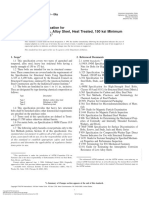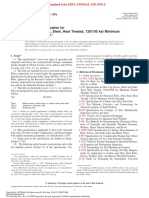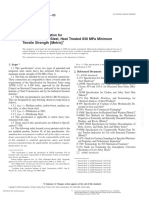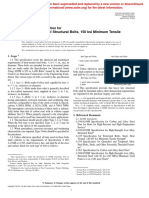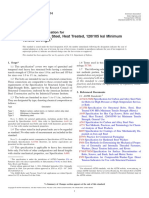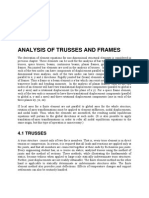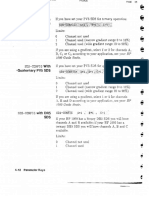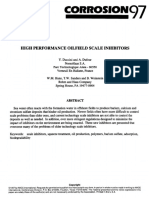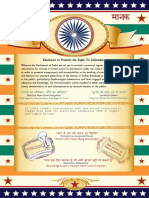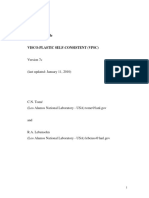Astm 470
Astm 470
Uploaded by
paty_cm2Copyright:
Available Formats
Astm 470
Astm 470
Uploaded by
paty_cm2Original Title
Copyright
Available Formats
Share this document
Did you find this document useful?
Is this content inappropriate?
Copyright:
Available Formats
Astm 470
Astm 470
Uploaded by
paty_cm2Copyright:
Available Formats
American Association State
Designation: A 490 – 04a Highway and Transportation
Officials Standard
AASHTO No.: M 253
Standard Specification for
Structural Bolts, Alloy Steel, Heat Treated, 150 ksi Minimum
Tensile Strength1
This standard is issued under the fixed designation A 490; the number immediately following the designation indicates the year of
original adoption or, in the case of revision, the year of last revision. A number in parentheses indicates the year of last reapproval. A
superscript epsilon (e) indicates an editorial change since the last revision or reapproval.
This standard has been approved for use by agencies of the Department of Defense.
1. Scope* 2. Referenced Documents
1.1 This specification covers two types of quenched and 2.1 ASTM Standards: 3
tempered, alloy steel, heavy hex structural bolts having a A 194/A 194M Specification for Carbon and Alloy Steel
tensile strength of 150 to 173 ksi. Nuts for Bolts for High-Pressure and High-Temperature
1.2 These bolts are intended for use in structural connec- Service
tions. These connections are covered under the requirements of A 325 Specification for Structural Bolts, Steel, Heat
the Specification for Structural Joints Using Specification Treated, 120/105 ksi Minimum Tensile Strength
A 325 or A 490 bolts, approved by the Research Council on A 354 Specification for Quenched and Tempered Alloy
Structural Connections; endorsed by the American Institute of Steel Bolts, Studs, and Other Externally Threaded Fasten-
Steel Construction and by the Industrial Fastener Institute.2 ers
1.3 The bolts are furnished in sizes 1⁄2 to 11⁄2 in., inclusive. A 490M Specification for High-Strength Steel Bolts,
They are designated by type denoting chemical composition as Classes 10.9 and 10.9.3, for Structural Steel Joints [Metric]
follows: A 563 Specification for Carbon and Alloy Steel Nuts
Type Description A 751 Test Methods, Practices, and Terminology for
Chemical Analysis of Steel Products
Type 1 Medium carbon alloy steel
Type 2 Withdrawn in 2002
D 3951 Practice for Commercial Packaging
Type 3 Weathering steel E 384 Test Method for Microindentationhardness of Mate-
rials
1.4 This specification provides that heavy hex structural
E 709 Guide for Magnetic Particle Examination
bolts shall be furnished unless other dimensional requirements
E 1444 Practice for Magnetic Particle Inspection
are specified on the purchase order.
F 436 Specification for Hardened Steel Washers
1.5 Terms used in this specification are defined in Termi-
F 606 Test Methods for Determining the Mechanical Prop-
nology F 1789 unless otherwise defined herein.
erties of Externally and Internally Threaded Fasteners,
1.6 For metric bolts, see Specification A 490M Classes 10.9
Washers, and Rivets
and 10.9.3
F 788/F 788M Specification for Surface Discontinuities of
1.7 The following safety hazards caveat pertains only to the
Bolts, Screws, and Studs, Inch and Metric Series
Test Methods portion, Section 12 of this specification: This
F 959 Specification for Compressible-Washer-Type Direct
standard does not purport to address all of the safety concerns,
Tension Indicators for Use with Structural Fasteners
if any, associated with its use. It is the responsibility of the user
F 1470 Guide for Fastener Sampling for Specified Mechani-
of this standard to establish appropriate safety and health
--`,,``,`,``,``,`````,,,,,`,-`-`,,`,,`,`,,`---
cal Properties and Performance Inspection
practices and determine the applicability of regulatory limita-
F 1789 Terminology for F16 Mechanical Fasteners
tions prior to use.
G 101 Guide for Estimating the Atmospheric Corrosion
Resistance of Low-Alloy Steels
1
This specification is under the jurisdiction of ASTM Committee F16 on
Fasteners and is the direct responsibility of Subcommittee F16.02 on Steel Bolts,
3
Nuts, Rivets, and Washers. For referenced ASTM standards, visit the ASTM website, www.astm.org, or
Current edition approved Aug. 1, 2004. Published August 2004. Originally contact ASTM Customer Service at service@astm.org. For Annual Book of ASTM
approved in 1964. Last previous edition approved in 2004 as A 490 – 04. Standards volume information, refer to the standard’s Document Summary page on
2
Available from American Institute of Steel Construction (AISC), One E. the ASTM website.
Wacker Dr., Suite 3100, Chicago, IL 60601-2001.
*A Summary of Changes section appears at the end of this standard.
Copyright © ASTM International, 100 Barr Harbor Drive, PO Box C700, West Conshohocken, PA 19428-2959, United States.
Copyright ASTM International 1
Reproduced by IHS under license with ASTM Licensee=Loc 25-27Venezuela/Parlaguan,Puerto la Cr,San Die/5919206111, User=hern
No reproduction or networking permitted without license from IHS Not for Resale, 10/27/2005 14:55:08 MDT
A 490 – 04a
2.2 ASME Standards:4 4. Materials and Manufacture
B1.1 Unified Screw Threads 4.1 Heat Treatment—Type 1 and Type 3 bolts shall be heat
B18.2.6 Fasteners for Use in Structural Applications treated by quenching in oil from the austenitic temperature and
B18.24.1 Part Identifying Number (PIN) Code System then tempered by reheating to a temperature of not less than
2.3 SAE Standard:5 800°F.
J121 Decarburization in Hardened and Tempered Threaded 4.2 Threading:
Fasteners The threads shall be cut or rolled.
4.3 Protective Coatings—The bolts shall not be coated by
3. Ordering Information
hot-dip zinc coating, mechanical deposition, or electroplating
3.1 Orders for heavy hex structural bolts under this speci- with zinc or other metallic coatings (Note 2).
fication shall include the following:
3.1.1 Quantity (number of pieces of bolts and accessories); NOTE 2—For more detail see the H. E. Townsend Report “Effects of
Zinc Coatings on Stress Corrosion Cracking and Hydrogen Embrittlement
3.1.2 Size, including nominal bolt diameter, thread pitch,
of Low Alloy Steel,” published in Metallurgical Transactions, Vol. 6, April
and bolt length. The thread length shall not be changed; 1975.
3.1.3 Name of product: heavy hex structural bolts, or other
such bolts as specified; 5. Chemical Composition
3.1.4 Type of bolt (Type 1 or 3). When type is not specified, 5.1 Type 1 bolts shall be alloy steel conforming to the
either Type 1 or Type 3 shall be furnished at the supplier’s chemical composition specified in Table 1. The steel shall
option; contain sufficient alloying elements to qualify it as an alloy
3.1.5 ASTM designation and year of issue, steel (see Note 3).
3.1.6 Other components such as nuts, washers, and washer-
type direct tension indicators, if required; NOTE 3—Steel is considered to be alloy by the American Iron and Steel
Institute when the maximum of the range given for the content of alloying
3.1.7 Test Reports, if required (see 15); and elements exceeds one or more of the following limits: manganese, 1.65 %;
3.1.8 Special requirements. silicon, 0.60 %; copper, 0.60 %; or in which a definite range or a definite
3.1.9 For establishment of a part identifying system, see minimum quantity of any of the following elements is specified or
ASME B18.24.1. required within the limits of the recognized field of constructional alloy
steels: aluminum, chromium up to 3.99 %, cobalt, columbium, molybde-
NOTE 1—A typical ordering description follows: 1000 pieces 1–8 in. num, nickel, titanium, tungsten, vanadium, zirconium, or any other
dia 3 4 in. long heavy hex structural bolt, Type 1, ASTM A 490 – 02; each alloying elements added to obtain a desired alloying effect.
with two hardened washers, ASTM F 436 Type 1; and one heavy hex nut,
ASTM A 563 Grade DH. 5.2 Type 3 bolts shall be weathering steel conforming to the
3.2 Recommended Nuts: chemical composition requirements in Table 2. See Guide
3.2.1 Nuts conforming to the requirements of Specification G 101 for methods of estimating the atmospheric corrosion
A 563 are the recommended nuts for use with Specification resistance of low alloy steel.
A 490 heavy hex structural bolts. The nuts shall be of the class 5.3 Product analyses made on finished bolts representing
and have a surface finish for each type of bolt as follows: each lot shall conform to the product analysis requirements
specified in Table 1 or Table 2, as applicable.
Bolt Type and Finish Nut Class and Finish
5.4 Heats of steel to which bismuth, selenium, tellurium, or
1, plain (uncoated) A 563—DH, DH3 plain (uncoated) lead has been intentionally added shall not be used for bolts
3, weathering steel A 563—DH3, weathering steel furnished to this specification. Compliance with this require-
--`,,``,`,``,``,`````,,,,,`,-`-`,,`,,`,`,,`---
3.2.2 Alternatively, nuts conforming to Specification A 194/ ment shall be based on certification that steels having these
A 194M Gr. 2H plain (uncoated) are considered a suitable elements intentionally added were not used.
substitute for use with Specification A 490 Type 1 heavy hex 5.5 Chemical analyses shall be performed in accordance
structural bolts. with Test Methods, Practices, and Terminology A 751.
3.3 Recommended Washers—Washers conforming to Speci-
fication F 436 are the recommended washers for use with 6. Mechanical Properties
Specification A 490 heavy hex structural bolts. The washers 6.1 Hardness—The bolts shall conform to the hardness
shall have a surface finish for each type of bolt as follows: specified in Table 3.
Bolt Type and Finish Washer Finish 6.2 Tensile Properties:
1, plain (uncoated) plain (uncoated)
3, weathering steel weathering steel
TABLE 1 Chemical Requirements for Type 1 Bolts
3.4 Other Accessories—When compressible washer type
direct tension indicators are specified to be used with these Element Heat Analysis, % Product
Analysis, %
bolts, they shall conform to Specification F 959 Type 490.
Carbon
For sizes through 13⁄8 in. 0.30–0.48 0.28–0.50
For size 11⁄2 in. 0.35–0.53 0.33–0.55
4
Available from American Society of Mechanical Engineers (ASME), ASME Phosphorus, max 0.040 0.045
International Headquarters, Three Park Ave., New York, NY 10016-5990. Sulfur, max 0.040 0.045
5
Available from Society of Automotive Engineers (SAE), 400 Commonwealth Alloying Elements → See 5.1 ←
Dr., Warrendale, PA 15096-0001.
Copyright ASTM International 2
Reproduced by IHS under license with ASTM Licensee=Loc 25-27Venezuela/Parlaguan,Puerto la Cr,San Die/5919206111, User=hern
No reproduction or networking permitted without license from IHS Not for Resale, 10/27/2005 14:55:08 MDT
A 490 – 04a
TABLE 2 Chemical Requirements for Type 3 Bolts 8.2 Threads—Threads shall be the Unified Coarse Thread
Series as specified in ASME B1.1 and shall have Class 2A
Element Heat Analysis, % Product Analysis, %
tolerances. When specified, 8 pitch thread series shall be used
Carbon
Sizes 0.75 in. and smaller 0.20–0.53 0.19–0.55
on bolts over 1 in. in diameter.
Sizes larger than 0.75 in. 0.30–0.53 0.28–0.55
Manganese, min 0.40 0.37 9. Workmanship
Phosphorus, max 0.035 0.040
Sulfur, max 0.040 0.045 9.1 The allowable limits, inspection, and evaluation of the
Copper 0.20–0.60 0.17–0.63 surface discontinuities, quench cracks, forging cracks, head
Chromium, min 0.45 0.42
Nickel, min 0.20 0.17 bursts, shear bursts, seams, folds, thread laps, voids, tool
or marks, nicks, and gouges shall be in accordance with Specifi-
Molybdenum, min 0.15 0.14 cation F 788/F 788M (see Note 4).
NOTE 4—Specification F 788/F 788M nor Guide F 1470 do not guar-
6.2.1 Except as permitted in 6.2.2 for long bolts and 6.2.3 antee 100 % freedom from head bursts. Sampling is designed to provide
a 95 % confidence level of freedom from head bursts in any test lot. Head
for short bolts, sizes 1.00 in. and smaller having a length of 21⁄4
bursts, within the limits in Specification F 788/F 788M, are unsightly but
D and longer and sizes larger than 1.00 in. having a length of do not affect mechanical properties or functional requirements of the bolt.
3D and longer shall be wedge tested full size and shall conform
to the minimum and maximum wedge tensile load, and proof 10. Magnetic Particle Inspection for Longitudinal
--`,,``,`,``,``,`````,,,,,`,-`-`,,`,,`,`,,`---
load or alternative proof load specified in Table 4. The load Discontinuities and Transverse Cracks
achieved during proof load testing shall be equal to or greater
10.1 Requirements:
than the specified proof load.
10.1.1 Each sample representative of the lot shall be mag-
6.2.2 When the length of the bolt makes full-size testing
netic particle inspected for longitudinal discontinuities and
impractical, machined specimens shall be tested and shall
transverse cracks.
conform to the requirements specified in Table 5. When bolts
10.1.2 The lot, as represented by the sample, shall be free
are tested by both full-size and machined specimen methods,
from nonconforming bolts, as defined in 10.3, when inspected
the full-size test shall take precedence.
in accordance with 10.2.1-10.2.4.
6.2.3 Sizes 1.00 in. and smaller having a length shorter than
21⁄4 D down to 2D, inclusive, that cannot be wedge tensile 10.2 Inspection Procedure:
tested shall be axially tension tested full size and shall conform 10.2.1 The inspection sample shall be selected at random
to the minimum tensile load and proof load or alternate proof from each lot in accordance with Table 6 and examined for
load specified in Table 4. Sizes 1.00 in. and smaller having a longitudinal discontinuities and transverse cracks.
length shorter than 2D that cannot be axially tensile tested shall 10.2.2 Magnetic particle inspection shall be conducted in
be qualified on the basis of hardness. accordance with Guide E 709 or Practice E 1444. Guide E 709
6.2.4 For bolts on which hardness and tension tests are shall be used for referee purposes. If any nonconforming bolt
performed, acceptance based on tensile requirements shall take is found during the manufacturer’s examination of the lot
precedence in the event of low hardness readings. selected in 10.2.1, the lot shall be 100 % magnetic particle
inspected, and all nonconforming bolts shall be removed and
7. Carburization/Decarburization scrapped or destroyed.
7.1 This test is intended to evaluate the presence or absence 10.2.3 Eddy current or liquid penetrant inspection shall be
of carburization and decarburization as determined by the an acceptable substitute for the 100 % magnetic particle
difference in microhardness near the surface and core. inspection when nonconforming bolts are found and 100 %
7.2 Requirements: inspection is required. On completion of the eddy current or
7.2.1 Carburization—The bolts shall show no evidence of a liquid penetrant inspection, a random sample selected from
carburized surface when evaluated in accordance with 12.2. each lot in accordance with Table 5 shall be re-examined by the
7.2.2 Decarburization—Hardness value differences shall magnetic particle method. In case of controversy, the magnetic
not exceed the requirements set forth for decarburization in particle test shall take precedence.
SAE J121 for Class 2/3H materials when evaluated in accor- 10.2.4 Magnetic particle indications of themselves shall not
dance with 12.2. be cause for rejection. If in the opinion of the quality assurance
representative the indications may be cause for rejection, a
8. Dimensions sample taken in accordance with Table 5 shall be examined by
8.1 Head and Body: microscopic examination or removal by surface grinding to
8.1.1 Unless otherwise specified, bolts shall conform to the determine if the indicated discontinuities are within the speci-
dimensions for heavy hex structural bolts specified in ASME fied limits.
B18.2.6. 10.3 Definitions:
8.1.2 The thread length shall not be changed from that 10.3.1 Nonconforming Bolts—Any bolt with a longitudinal
specified in ASME B18.2.6 for heavy hex structural bolts. discontinuity (located parallel to the axis of the bolt in the
Bolts requiring thread lengths other than those required by this threads, body, fillet, or underside of head), with a depth normal
specification shall be ordered under Specification A 354 Gr. to the surface greater than 0.03D, where D is the nominal
BD. diameter in inches, shall be considered nonconforming. In
Copyright ASTM International 3
Reproduced by IHS under license with ASTM Licensee=Loc 25-27Venezuela/Parlaguan,Puerto la Cr,San Die/5919206111, User=hern
No reproduction or networking permitted without license from IHS Not for Resale, 10/27/2005 14:55:08 MDT
A 490 – 04a
TABLE 3 Hardness Requirements for Bolts
1⁄2 to 11⁄2 in. Nominal Size
Brinell Rockwell C
Size, in. Length, in.
min max min max
⁄
12 to 1, incl. Less than 2DA 311 352 33 39
2DA and longer ... 352 ... 39
Over 1 to 11⁄2 , incl. Less than 3DA 311 352 33 39
3DA and longer ... 352 ... 39
A
Heavy hex structural bolts 1 in. and smaller and shorter than 2D are subject only to minimum and maximum hardness. Heavy hex structural bolts larger than 1 through
11⁄2 , incl., in diameter and shorter than 3D are subject only to minimum and maximum hardness.
TABLE 4 Tensile Load Requirements for Full-Size Bolts
Alternative Proof
Proof Load,B
Bolt Size, Threads Tensile Load,B lbf Load,B
lbf
per Inch, and Stress Area,A in.2 lbf
Series Designation Length Measure- Yield Strength
min max
ment Method Method
Column 1 Column 2 Column 3 Column 4 Column 5 Column 6
⁄ -13 UNC
12 0.142 21 300 24 600 17 050 18 500
5⁄8-11 UNC 0.226 33 900 39 100 27 100 29 400
3⁄4-10 UNC 0.334 50 100 57 800 40 100 43 400
7⁄8-9 UNC 0.462 69 300 79 950 55 450 60 100
1-8 UNC 0.606 90 900 104 850 72 700 78 800
11⁄8-7 UNC 0.763 114 450 132 000 91 550 99 200
11⁄8-8 UN 0.790 118 500 136 700 94 800 102 700
11⁄4-7 UNC 0.969 145 350 167 650 116 300 126 000
11⁄4-8 UN 1.000 150 000 173 000 120 000 130 000
13⁄8-6 UNC 1.155 173 250 199 850 138 600 150 200
13⁄8-8 UN 1.233 185 000 213 350 148 000 160 300
11⁄2-6 UNC 1.405 210 750 243 100 168 600 182 600
11⁄2-8 UN 1.492 223 800 258 150 179 000 194 000
A
The stress area is calculated as follows:
As = 0.7854 [D − (0.9743/n)]2
where:
As = stress area, in.2
D = nominal bolt size, and
n = threads per inch.
B
Loads tabulated and loads to be used for tests of full-size bolts larger than 11⁄2 in. in diameter are based on the following:
Bolt Size Column 3 Column 4 Column 5 Column 6
⁄
12 to 11⁄2 in., incl 150 000 psi 173 000 psi 120 000 psi 130 000 psi
TABLE 5 Tensile Strength Requirements for Specimens TABLE 6 Sample Sizes with Acceptance and Rejection Numbers
Machined from Bolts for Inspection of Rejectable Longitudinal Discontinuities and
Transverse Cracks
Tensile Yield
Elongation
Strength, Strength Reduction Acceptance Rejection
in 2 in. or Lot Size Sample Size,A
Bolt Size, in. psi (0.2 %
50 mm,
of Area, NumberA Number
offset), min, %
min max min, % 2 to 50 all 0 1
min, psi
51 to 500 50 0 1
⁄ to 1 ⁄ in.,
12 12 150 000 173 000 130 000 14 40 501 to 1200 80 0 1
incl 1201 to 3200 125 0 1
3201 to 10 000 200 0 1
A
Inspect all bolts in the lot if lot size is less than sample size.
addition, any bolt with a transverse crack (located perpendicu-
lar to the axis of the bolt in the threads, body, fillet, or
underside of head) detectable by magnetic particle inspection, 11.1.1 Each lot shall be tested by the manufacturer prior to
shall be considered nonconforming. shipment in accordance with the lot identification control
quality assurance plan in 11.2-11.5.
11. Number of Tests and Retests 11.1.2 When bolts are furnished by a source other than the
11.1 Testing Responsibility: manufacturer, the Responsible Party as defined in 16.1 shall be
--`,,``,`,``,``,`````,,,,,`,-`-`,,`,,`,`,,`---
Copyright ASTM International 4
Reproduced by IHS under license with ASTM Licensee=Loc 25-27Venezuela/Parlaguan,Puerto la Cr,San Die/5919206111, User=hern
No reproduction or networking permitted without license from IHS Not for Resale, 10/27/2005 14:55:08 MDT
A 490 – 04a
responsible for assuring all tests have been performed and the 13. Inspection
bolts comply with the requirements of this specification. 13.1 If the inspection described in 13.2 is required by the
11.2 Purpose of Lot Inspection—The purpose of a lot purchaser, it shall be specified in the inquiry and contract or
inspection program shall be to ensure that each lot as repre- order.
sented by the samples tested conforms to the requirements of 13.2 The purchaser’s representative shall have free entry to
this specification. For such a plan to be fully effective, it is all parts of manufacturer’s works or supplier’s place of
essential that secondary processors, distributors, and purchas- business that concern the manufacture of the material ordered.
ers maintain the identification and integrity of each lot until the The manufacturer or supplier shall afford the purchaser’s
product is installed. representative all reasonable facilities to satisfy him that the
11.3 Lot Method—All bolts shall be processed in accor- material is being furnished in accordance with this specifica-
dance with a lot identification-control quality assurance plan. tion. All tests and inspections required by the specification that
The manufacturer, secondary processors, and distributors shall are requested by the purchaser’s representative shall be made
identify and maintain the integrity of each lot of bolts from before shipment, and shall be conducted as not to interfere
raw-material selection through all processing operations and unnecessarily with the operation of the manufacturer’s works
treatments to final packing and shipment. Each lot shall be or supplier’s place of business.
assigned its own lot-identification number, each lot shall be
tested, and the inspection test reports for each lot shall be 14. Rejection and Rehearing
retained. 14.1 Disposition of nonconforming material shall be in
11.4 Lot Definition—A lot shall be a quantity of uniquely accordance with Guide F 1470 section titled “Disposition of
identified heavy hex structural bolts of the same nominal size Nonconforming Lots.”
and length produced consecutively at the initial operation from
15. Certification
a single mill heat of material and processed at one time, by the
same process, in the same manner, so that statistical sampling 15.1 When specified on the purchase order, the manufac-
is valid. The identity of the lot and lot integrity shall be turer or supplier, whichever is the responsible party as defined
maintained throughout all subsequent operations and packag- in Section 16 shall furnish the purchaser a test report that
ing. includes the following:
11.5 Number of Tests: 15.1.1 Heat analysis, heat number, and a statement certify-
ing that heats having bismuth, selenium, tellurium, or lead
11.5.1 The minimum number of tests from each lot for the
intentionally added were not used to produce the bolts;
tests specified below shall be as follows:
15.1.2 Results of hardness, tensile, and proof load tests;
Tests Number of Tests in Accordance with
15.1.3 Results of magnetic particle inspection for longitu-
Hardness, tensile strength, proof load Guide F 1470a dinal discontinuities and transverse cracks;
Surface discontinuities Specification F 788/F 788M 15.1.4 Results of tests and inspections for surface disconti-
Magnetic particle inspection Table 5
Dimensions and thread fit ASME B18.2.6 nuities including visual inspection for head bursts;
15.1.5 Results of carburization and decarburization tests;
11.5.2 For carburization and decarburization tests, not less 15.1.6 Statement of compliance with dimensional and
than one sample unit per manufactured lot shall be tested for thread fit requirements;
microhardness. 15.1.7 Lot number and purchase order number;
15.1.8 Complete mailing address of responsible party; and
12. Test Methods 15.1.9 Title and signature of the individual assigned certi-
12.1 Tensile, Proof Load, and Hardness: fication responsibility by the company officers.
12.1.1 Tensile, proof load, and hardness tests shall be 15.2 Failure to include all the required information on the
conducted in accordance with Test Methods F 606. test report shall be cause for rejection.
12.1.2 Tensile strength shall be determined using the Wedge 16. Responsibility
or Axial Tension Testing Method of Full Size Product Method
16.1 The party responsible for the fastener shall be the
or the Machined Test Specimens Method, depending on size
organization that supplies the fastener to the purchaser.
and length as specified in 6.2.1-6.2.4. Fracture on full-size tests
shall be in the body or threads of the bolt without a fracture at 17. Product Marking
the junction of the head and body. 17.1 Manufacturer’s Identification—All Type 1 and Type 3
12.1.3 Proof load shall be determined using Method 1, bolts shall be marked by the manufacturer with a unique
Length Measurement, or Method 2, Yield Strength, at the identifier to identify the manufacturer or private label distribu-
option of the manufacturer. tor, as appropriate.
12.2 Carburization/Decarburization—Tests shall be con- 17.2 Grade Identification:
ducted in accordance with SAE J121 Hardness Method. 17.2.1 Type 1 bolts shall be marked “A 490.”
12.3 Microhardness—Tests shall be conducted in accor- 17.2.2 Type 3 bolts shall be marked “A 490” underlined.
dance with Test Method E 384. 17.3 Marking Location and Methods—All marking shall be
12.4 Magnetic Particle—Inspection shall be conducted in located on the top of the bolt head and shall be either raised or
accordance with Section 10. depressed at the manufacturer’s option.
--`,,``,`,``,``,`````,,,,,`,-`-`,,`,,`,`,,`---
Copyright ASTM International 5
Reproduced by IHS under license with ASTM Licensee=Loc 25-27Venezuela/Parlaguan,Puerto la Cr,San Die/5919206111, User=hern
No reproduction or networking permitted without license from IHS Not for Resale, 10/27/2005 14:55:08 MDT
A 490 – 04a
17.4 Acceptance Criteria—Bolts that are not marked in 18.2 Package Marking:
accordance with these provisions shall be considered noncon- 18.2.1 Each shipping unit shall include or be plainly marked
forming and subject to rejection. with the following information:
17.5 Type and manufacturer’s or private label distributor’s 18.2.1.1 ASTM designation and type,
identification shall be separate and distinct. The two identifi- 18.2.1.2 Size,
cations shall preferably be in different locations and, when on 18.2.1.3 Name and brand or trademark of the manufacturer,
the same level, shall be separated by at least two spaces.
18.2.1.4 Number of pieces,
18. Packaging and Package Marking 18.2.1.5 Lot number,
18.1 Packaging: 18.2.1.6 Purchase order number, and
18.1.1 Unless otherwise specified, packaging shall be in 18.2.1.7 Country of origin.
accordance with Practice D 3951.
18.1.2 When special packaging requirements are required, 19. Keywords
--`,,``,`,``,``,`````,,,,,`,-`-`,,`,,`,`,,`---
they shall be defined at the time of the inquiry and order. 19.1 bolts; alloy steel; steel; structural; weathering steel
SUMMARY OF CHANGES
Committee F16 has identified the location of selected changes to this standard since the last issue, A 490 – 04,
that may impact the use of this standard. (Approved Aug. 1, 2004.)
(1) Deleted title of 7.1. (3) Revised Section 16, Responsibility.
(2) Deleted 7.3 because it was redundant with 12.2.
Committee F16 has identified the location of selected changes to this standard since the last issue, A 490 – 02, that may
impact the use of this standard. (Approved Jan. 1, 2004.)
(1) Revised 6.2.1 to include compliance with the maximum (3) Revised 9.1 to include a note recognizing that Specifica-
tensile values to align with Tables 4 and 5. tion F 788/F 788M nor Specification F 470 guarantees 100 %
(2) In 7.2.1, changed “as” to “no” to correct a typo. freedom from head burst.
ASTM International takes no position respecting the validity of any patent rights asserted in connection with any item mentioned
in this standard. Users of this standard are expressly advised that determination of the validity of any such patent rights, and the risk
of infringement of such rights, are entirely their own responsibility.
This standard is subject to revision at any time by the responsible technical committee and must be reviewed every five years and
if not revised, either reapproved or withdrawn. Your comments are invited either for revision of this standard or for additional standards
and should be addressed to ASTM International Headquarters. Your comments will receive careful consideration at a meeting of the
responsible technical committee, which you may attend. If you feel that your comments have not received a fair hearing you should
make your views known to the ASTM Committee on Standards, at the address shown below.
This standard is copyrighted by ASTM International, 100 Barr Harbor Drive, PO Box C700, West Conshohocken, PA 19428-2959,
United States. Individual reprints (single or multiple copies) of this standard may be obtained by contacting ASTM at the above
address or at 610-832-9585 (phone), 610-832-9555 (fax), or service@astm.org (e-mail); or through the ASTM website
(www.astm.org).
Copyright ASTM International 6
Reproduced by IHS under license with ASTM Licensee=Loc 25-27Venezuela/Parlaguan,Puerto la Cr,San Die/5919206111, User=hern
No reproduction or networking permitted without license from IHS Not for Resale, 10/27/2005 14:55:08 MDT
You might also like
- Alcon IOL CatalogDocument18 pagesAlcon IOL CatalogMeiliaty Angky100% (1)
- CSEC MATH PAST PAPER AlgebraDocument24 pagesCSEC MATH PAST PAPER AlgebraThomasine Edwards94% (16)
- Astm A563-07aDocument9 pagesAstm A563-07aJhonata ChimeloNo ratings yet
- Chemistry Lab1 PDF - 06-13Document11 pagesChemistry Lab1 PDF - 06-13cagdianad Dj100% (2)
- Astm A 490Document6 pagesAstm A 490Pedro Diaz UzcateguiNo ratings yet
- Structural Bolts, Alloy Steel, Heat Treated, 150 Ksi Minimum Tensile StrengthDocument6 pagesStructural Bolts, Alloy Steel, Heat Treated, 150 Ksi Minimum Tensile Strengthcomercial.excelsior1No ratings yet
- ASTM A490M Rev A (2004) STD SPECS FOR STRUCL BOLT ALLOY STEE PDFDocument6 pagesASTM A490M Rev A (2004) STD SPECS FOR STRUCL BOLT ALLOY STEE PDFCharwin PicaoNo ratings yet
- Astm A325 PDFDocument8 pagesAstm A325 PDFDjoko SugihatoNo ratings yet
- Structural Bolts, Steel, Heat Treated, 120/105 Ksi Minimum Tensile StrengthDocument8 pagesStructural Bolts, Steel, Heat Treated, 120/105 Ksi Minimum Tensile StrengthGhulam DastaggirNo ratings yet
- Structural Bolts, Steel, Heat Treated, 120/105 Ksi Minimum Tensile StrengthDocument8 pagesStructural Bolts, Steel, Heat Treated, 120/105 Ksi Minimum Tensile StrengthMichael Kenyi Huamán TitoNo ratings yet
- ASTM A490 Standard Specification For Structural Bolts Alloy Steel Heat Treated 150 Ksi Minimum Tensile StrengthDocument6 pagesASTM A490 Standard Specification For Structural Bolts Alloy Steel Heat Treated 150 Ksi Minimum Tensile StrengthSteve JonesNo ratings yet
- A 325M - 04 - Qtmynu0Document8 pagesA 325M - 04 - Qtmynu0krutikNo ratings yet
- Structural Bolts, Steel, Heat Treated 830 Mpa Minimum Tensile Strength (Metric)Document7 pagesStructural Bolts, Steel, Heat Treated 830 Mpa Minimum Tensile Strength (Metric)Deen ewNo ratings yet
- Astm A490 2011 PDFDocument6 pagesAstm A490 2011 PDFMuhammed ShafiNo ratings yet
- Astm 325MDocument8 pagesAstm 325MCPA BTKNo ratings yet
- Structural Bolts, Steel, Heat Treated, 120/105 Ksi Minimum Tensile StrengthDocument8 pagesStructural Bolts, Steel, Heat Treated, 120/105 Ksi Minimum Tensile StrengthCarlos Raul Caballero LeonNo ratings yet
- Astm A325-03 STD Specs For Structural Bolts, Steel, Heat PDFDocument7 pagesAstm A325-03 STD Specs For Structural Bolts, Steel, Heat PDFCharwin PicaoNo ratings yet
- ASTM A563-04aDocument8 pagesASTM A563-04a원영철No ratings yet
- ASTM A325M Rev B (2004) STD SPECS FOR STRUCTURAL BOLTS, STEEDocument7 pagesASTM A325M Rev B (2004) STD SPECS FOR STRUCTURAL BOLTS, STEECharwin PicaoNo ratings yet
- A 325 Structural Bolts, Steel, Heat Treated 830 MPa Minimum Tensile Strength (Metric)Document7 pagesA 325 Structural Bolts, Steel, Heat Treated 830 MPa Minimum Tensile Strength (Metric)Laziz AtmaniNo ratings yet
- ASTM-A-325-02 Standard Specification For Structural Bolts. Steel, Heat Treated, 120 - 105 Ksi Minimum Tensile Strength PDFDocument8 pagesASTM-A-325-02 Standard Specification For Structural Bolts. Steel, Heat Treated, 120 - 105 Ksi Minimum Tensile Strength PDFFattahi KarimNo ratings yet
- Astm A325 PDFDocument8 pagesAstm A325 PDFEdwin Franklin Cahuana CcopaNo ratings yet
- Hex Cap Screws, Bolts and Studs, Steel, Heat Treated, 120/ 105/90 Ksi Minimum Tensile Strength, General UseDocument7 pagesHex Cap Screws, Bolts and Studs, Steel, Heat Treated, 120/ 105/90 Ksi Minimum Tensile Strength, General Usecomercial.excelsior1No ratings yet
- A 325 Â " 02 QTMYNS0WMG - PDFDocument8 pagesA 325 Â " 02 QTMYNS0WMG - PDFMytzy Godoy TapiaNo ratings yet
- Structural Bolts, Alloy Steel, Heat Treated, 150 Ksi Minimum Tensile StrengthDocument6 pagesStructural Bolts, Alloy Steel, Heat Treated, 150 Ksi Minimum Tensile Strengthalucard375No ratings yet
- Structural Bolts, Steel, Heat Treated, 120/105 Ksi Minimum Tensile StrengthDocument1 pageStructural Bolts, Steel, Heat Treated, 120/105 Ksi Minimum Tensile StrengthAhmed Hamed ElezabyNo ratings yet
- A 490 - 00 - Qtq5mc0wmaDocument7 pagesA 490 - 00 - Qtq5mc0wmaAnderson VelandiaNo ratings yet
- Structural Bolts, Alloy Steel, Heat Treated, 150 Ksi Minimum Tensile StrengthDocument6 pagesStructural Bolts, Alloy Steel, Heat Treated, 150 Ksi Minimum Tensile Strengthalucard375No ratings yet
- High-Strength Steel Bolts, Classes 10.9 and 10.9.3, For Structural Steel Joints (Metric)Document6 pagesHigh-Strength Steel Bolts, Classes 10.9 and 10.9.3, For Structural Steel Joints (Metric)Ngoc BuiNo ratings yet
- Astm A325m-05Document7 pagesAstm A325m-05NadhiraNo ratings yet
- Astm F436.04 PDFDocument6 pagesAstm F436.04 PDFWelington Volpatto MoraisNo ratings yet
- Selection of Committee F16 Fastener Specifications: Standard Guide ForDocument15 pagesSelection of Committee F16 Fastener Specifications: Standard Guide ForLeonardo GomideNo ratings yet
- Astm A325-04 STD Specs For Structural Bolts, Steel, Heat TreDocument8 pagesAstm A325-04 STD Specs For Structural Bolts, Steel, Heat TreCharwin Picao100% (1)
- Astm A563 A563m 21Document7 pagesAstm A563 A563m 21zhang binNo ratings yet
- ASTM A354-2007aDocument6 pagesASTM A354-2007aJohn “JOHN” DonNo ratings yet
- 016 - Astm A325Document8 pages016 - Astm A325Victor AcuñaNo ratings yet
- A354 PDFDocument7 pagesA354 PDFDeen ewNo ratings yet
- Quenched and Tempered Alloy Steel Bolts, Studs, and Other Externally Threaded FastenersDocument7 pagesQuenched and Tempered Alloy Steel Bolts, Studs, and Other Externally Threaded FastenerssiderqualidadeNo ratings yet
- Astm F593Document8 pagesAstm F593fcoespinosa100% (1)
- F 1852 - 04 "Twist Off" Type Tension Control Structural BoltNutWasherDocument8 pagesF 1852 - 04 "Twist Off" Type Tension Control Structural BoltNutWasheribson045001256No ratings yet
- F 836M - 02 - RJGZNK0Document7 pagesF 836M - 02 - RJGZNK0krutikNo ratings yet
- Stainless Steel Bolts, Hex Cap Screws, and Studs: Standard Specification ForDocument8 pagesStainless Steel Bolts, Hex Cap Screws, and Studs: Standard Specification ForRICARDONo ratings yet
- A325m 14 PDFDocument8 pagesA325m 14 PDFjigarshah21No ratings yet
- A325 PDFDocument8 pagesA325 PDFGHULAM NABINo ratings yet
- Astm 394 Hot Dip Gal CoatedDocument6 pagesAstm 394 Hot Dip Gal Coatedeab65051No ratings yet
- A490m 12Document7 pagesA490m 12Plinio LavinasNo ratings yet
- Astm F436M 2000Document5 pagesAstm F436M 2000Jesse ChenNo ratings yet
- ASTM F 436 - Standard Specification For Hardened Steel WashersDocument6 pagesASTM F 436 - Standard Specification For Hardened Steel Washersvijaysharvesh01No ratings yet
- Astm A 217 - 04Document4 pagesAstm A 217 - 04Raul Humberto Mora VillamizarNo ratings yet
- Astm A325Document8 pagesAstm A325Nacer KisyNo ratings yet
- Astm F984Document9 pagesAstm F984ashu23283No ratings yet
- ASTM A563 Tuercas de Aleacion Acero y CarbonoDocument9 pagesASTM A563 Tuercas de Aleacion Acero y CarbonoMarco GonzaNo ratings yet
- Astm A0490Document7 pagesAstm A0490ndt_inspectorNo ratings yet
- Structural Bolts, Steel, Heat Treated, 120/105 Ksi Minimum Tensile StrengthDocument8 pagesStructural Bolts, Steel, Heat Treated, 120/105 Ksi Minimum Tensile Strengthsagar_sonawane_21No ratings yet
- Astm A394-07 PDFDocument6 pagesAstm A394-07 PDFalifuat duyguNo ratings yet
- F1852 PDFDocument8 pagesF1852 PDFkirubaNo ratings yet
- ASTM A563 - 07 Standard Specification For Carbon and Alloy Steel NutsDocument8 pagesASTM A563 - 07 Standard Specification For Carbon and Alloy Steel NutsDagoberto AguilarNo ratings yet
- Astm A182Document17 pagesAstm A182David Francisco Plata DuranNo ratings yet
- Bolted Flanged Joint: Flanges, Studs & Gaskets. Recommended Practices for the Assembly of a Bolted Flange Joint.From EverandBolted Flanged Joint: Flanges, Studs & Gaskets. Recommended Practices for the Assembly of a Bolted Flange Joint.No ratings yet
- Hand Book For Steel Structure Quality Control on SiteFrom EverandHand Book For Steel Structure Quality Control on SiteNo ratings yet
- Advanced Materials for Emerging Applications Innovations, Improvements, Inclusion and ImpactFrom EverandAdvanced Materials for Emerging Applications Innovations, Improvements, Inclusion and ImpactNo ratings yet
- Astm 105 ADocument5 pagesAstm 105 Apaty_cm2No ratings yet
- D445 Kinematic Viscosity PDFDocument10 pagesD445 Kinematic Viscosity PDFpaty_cm2No ratings yet
- Analisis de AcieteDocument27 pagesAnalisis de Acietepaty_cm2No ratings yet
- Instruction Manual: Model 1665/ 1666/ 1667Document12 pagesInstruction Manual: Model 1665/ 1666/ 1667paty_cm2No ratings yet
- Tbs1000 ManualDocument159 pagesTbs1000 Manualpaty_cm2No ratings yet
- Soft Starters and Variable Speed DrivesDocument36 pagesSoft Starters and Variable Speed DrivesBudy AndikaNo ratings yet
- Ordinary Differential EquationsDocument8 pagesOrdinary Differential EquationsMülügêtá HãilêNo ratings yet
- Grillage Analysis of Cellular Decks With Inclined WebsDocument6 pagesGrillage Analysis of Cellular Decks With Inclined WebsLama20No ratings yet
- Application of Ammonium Sensor For Environment Analysis: Eugenia Eftimie Totu, Rares GirdeaDocument7 pagesApplication of Ammonium Sensor For Environment Analysis: Eugenia Eftimie Totu, Rares GirdeazosuaNo ratings yet
- Relations and Functions Class 12 Notes Maths Chapter 1Document11 pagesRelations and Functions Class 12 Notes Maths Chapter 1poda84No ratings yet
- Analysis of Frames Beams TrussesDocument17 pagesAnalysis of Frames Beams TrussesRameez AnwarNo ratings yet
- Rao, Kothari, PrakashDocument7 pagesRao, Kothari, PrakashOğuz Baran ÖzgözgüNo ratings yet
- Universes Within 106Document14 pagesUniverses Within 106Simed Ewei100% (4)
- MR Aviation Turbine Fuel (Def Stan 91 91 Issue 6)Document4 pagesMR Aviation Turbine Fuel (Def Stan 91 91 Issue 6)Karthik BalajiNo ratings yet
- 1012Document4 pages1012sdiamanNo ratings yet
- CR ArtifactsDocument69 pagesCR ArtifactsPriyanka Modi100% (2)
- Explosive SC Penetration Into Tuff RockDocument69 pagesExplosive SC Penetration Into Tuff RockBAYE JBPNo ratings yet
- Digital FiltersDocument14 pagesDigital FiltersRazvan ScarlatNo ratings yet
- Pioneer MJD508 MinidiskDocument72 pagesPioneer MJD508 MinidiskjjelectraNo ratings yet
- Agilent HP 1090 OvenDocument8 pagesAgilent HP 1090 OvenHamidNo ratings yet
- Lab Report Content: ME-341, Heat and Mass Transfer: ExperimentsDocument12 pagesLab Report Content: ME-341, Heat and Mass Transfer: ExperimentsAnonymous R7wV0zbMNo ratings yet
- Geography I.A.Document17 pagesGeography I.A.Jared Stewart0% (1)
- Dry Leaf Fire StarterDocument10 pagesDry Leaf Fire StarterDaniel UlulazamiNo ratings yet
- ME2308 Lab ManualDocument28 pagesME2308 Lab ManualNishanth ShannmugamNo ratings yet
- Glg101r2 Appendix e Lab ReportDocument4 pagesGlg101r2 Appendix e Lab ReportSusan TuckerNo ratings yet
- HW Work and Energy Ans Key First Half PDFDocument8 pagesHW Work and Energy Ans Key First Half PDFMartha Glorie Manalo WallisNo ratings yet
- Feedback Systems: An Introduction For Scientists and EngineersDocument43 pagesFeedback Systems: An Introduction For Scientists and EngineersArjun SharmaNo ratings yet
- Properties of MatterDocument34 pagesProperties of MatterMirza Adnan100% (2)
- High Performance Oilfield Scale InhibitorsDocument27 pagesHigh Performance Oilfield Scale InhibitorsRégis OngolloNo ratings yet
- Is 12444 1988 PDFDocument7 pagesIs 12444 1988 PDFSCRIBDNo ratings yet
- VPSC7c ManualDocument114 pagesVPSC7c ManualChandra ClarkNo ratings yet
- Chapter 4. Constraints, Trade-Off, and Standards ConstraintsDocument37 pagesChapter 4. Constraints, Trade-Off, and Standards ConstraintsjillyyumNo ratings yet





